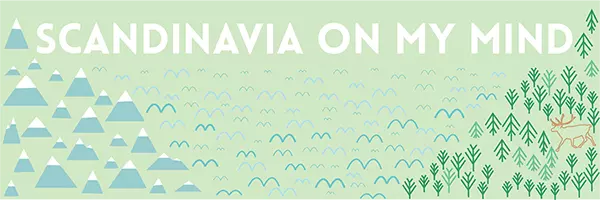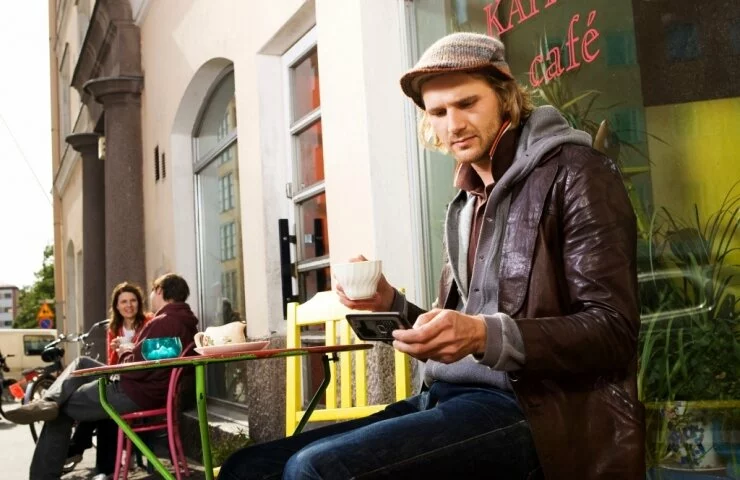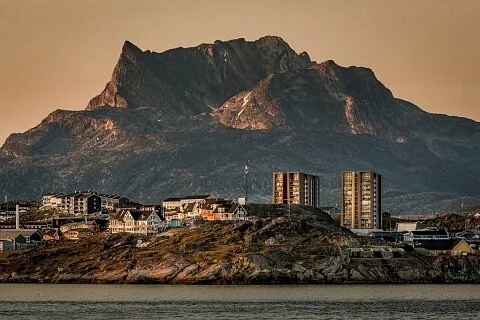If you don’t feel like you belong in the mainstream, you will feel right at home in Helsinki – especially when you know where to go.
The capital of Finland has always had plenty of room for the underground – be it the punk or student activist movement, minority rights groups, or just people who don’t feel like they fit the norms of society and would like to mingle with the like-minded.
To slap the hipster label on everything that even remotely challenges established norms is, of course, simplistic and perhaps unfair, so take the word hipster as a vague guideline here. The spots listed below are some of the havens in Helsinki for people who, to whatever degree, identify with the eccentrics and misfits of the society.
1 Kallio
Soaking up some sun (is that so surprising?) in Kallio Block. (Photo by Jussi Hellstén / Visit Hesinki)
The penetrating stare of an old church atop a hill is the first thing most people see when entering the district of Hakaniemi from the south.
Do not let the sight scare you off: judgmental and conservative values could not be further from the mindset of the area consisting of Hakaniemi, Harju, Vallila, Alppila, Alppiharju, Sörnäinen and Kallio, but often simply referred to as Kallio.
I lived in Kallio for eight years and saw it transform from a seedy red light district into a bohemian haven of quirky novelty stores, indie clubs, art galleries, vintage- and thrift stores, concept cafés, and some of the most inventive food in town, including superb ethnic, vegetarian, and street food restaurants.
Often listed as one of Europe’s hottest hipster destinations, the traditionally working class area has a politically charged history, and to this day, it is where cultural, social and ethnic diversity thrives more fiercely than anywhere else in Helsinki.
Many alternatively minded or marginalized groups – immigrants, goths, indie people, art students, punk rockers, the leftist intelligentsia – gather and mix here.
Kallio. (Photo by Samuli Launonen)
However, with rents skyrocketing beyond the reach of the lower class, the underground scene is slowly moving toward east. Particularly the area on and around the street of Vaasankatu, once notoriously run down and even dangerous, is gentrifying at a blindingly rapid pace.
Kallio’s past is not just political but somewhat drug- and crime-fuelled. The area bears these scars with pride and has not yet sacrificed its streetsmart identity for all-out capitalism. One of its trademarks, cheap alcohol, is still widely available in countless quaint gin joints, and on a weekend night, you will be hard pressed to find a person not merrily (or helplessly) intoxicated on the stuff.
Kallio is getting more hipstery and trendy by the day, and we all know what that means. Visit now, before it becomes yawn-inducingly middle-class.
Metro: Hakaniemi or Sörnäinen. Trams: 3, 6, 7, 8.
2 Punavuori
These two look like they’re living the Punavuori dream. (Photo by Samuli Launonen).
Gentrification always seems to take the same steps.
First, a run down neighborhood gets a makeover and starts to attract young people in search of affordable accommodation, such as students and struggling artists. They give the area a shot in the arm, bring in creativity and innovation, and attract like-minded people and businesses who cater to their needs.
Gradually, they get older and richer, and the area develops accordingly, becoming increasingly middle-class. At this point, a new generation of creative rebels is already busy elsewhere, turning another neighborhood into a hipster hot spot.
While Kallio (see above) is the current bohemian Shangri-La in Helsinki, Punavuori has long since reached the point of advanced gentrification. After passing the bohemian baton to Kallio, the area has become immaculately posh.
Now pricy and fashion-conscious, the district has held on to its aesthetic eye, and remains an exceptionally favourable location for designers and art gallerists to run their businesses – at least those prosperous enough to deal with the steep rents. Punavuori is known as the design quarter of Helsinki and has a country-wide reputation as an ultra-hip hipster utopia where organic lattes and red wine never run out.
The excellent Design Museum is located here, and one could spend weeks just browsing through the vintage record stores, designer clothing shops, art galleries and novelty shops such as the tiny Garageland, selling clothes and accessories for rockers and rockabillies, and Roobertin Herkku, the cutest little candy shop in town.
For all its upscale demeanor, the atmosphere in Punavuori is laid-back and surprisingly unpretentious. Its elegant bars and hip cafés attract a mixed clientele of local celebrities, expats and people of all sexual and gender identities.
Trams: 3, 6. Buses: 14, 20, 24.
3 Puu-Käpylä
Hippie or hipster? Whatever the case, there’s more to Käpylä than its wooden houses. (Photo by Jaakko Vähämäki / Vastavalo).
If we’re being nitpicky, Puu-Käpylä (Wood Käpylä) – the historic district of English-style wooden houses from the 1920s – might be more of a hippie haven than a hipster one, but who’s counting? All groups of people are welcome to share the communal vibes and tolerant values of the village within a city.
About half an hour north of downtown by bus or tram, Puu-Käpylä – part of the district of Käpylä – is a small world of its own. Snatching a home here is not easy. The residents know they are lucky to live here and cherish their surroundings with fervent passion.
In today’s Helsinki, it is generally not the norm for neighbours to communicate with each other at all, but Puu-Käpylä is a delightful exception. Year round, the inhabitants do all kinds of teamwork. They organize impromptu collective flea markets, maintain a shared rehearsal space for the budding musicians among their offspring, spend time together at the local pub, and so on.
The pinnacle of the communal daydream-turned-reality is Käpylän Kyläjuhlat (Käpylä Village Feast), an annual family-friendly festival in early June put together by locals as a labour of love. This is also the best way for a visitor to become part of the community for a day, as residents welcome outsiders to the pop up flea markets and cafés in their backyards.
If you are fortunate enough to be in Helsinki at the time of the feast, you will witness musicians from indie darlings to big stars play, and will be invited to people’s homes to sample cinnamon bun fresh from their ovens and juice from their home-grown apples. If you get here at a more quiet time, just stroll the beautiful, leafy boulevards – Puu-Käpylä is a stunner in all seasons.
Trams: 1 and 1A. Commuter trains: I, N, P and T.
4 The Cable Factory, Ruoholahti
The Cable Factory. (Photo by Samuli Launonen).
When you hop off the tram at Ruoholahti, the sight of modern highrises immediately to your right (or left, depending on which way you face) would have you believe you have just entered a wealthy residential area.
That impression only holds water until you turn to the opposite direction and enter the premises of the colossal hub of visual and performing arts called the Cable Factory.
The five-hectare, 56 000 square metre complex last served as an actual cable factory in 1987. At a time the word hipster hadn’t been so much as faintly whispered, the building was transformed into a cultural centre providing rehearsal rooms and studios for aspiring artists, exhibition halls, restaurants and stages for independent theatre productions.
Amazingly, the Cable Factory still stands as the biggest cultural centre of the city, and has kept its finger firmly on the pulse of the latest trends in photography and illustration arts, modern dance, underground theatre, and alternative music.
The building and yours truly go back a long way. Through the years, I have taken part in an oil painting course, attended the Finnish film industry’s annual awards gala, rented a rehearsal room for my tragicomic late-adolescence attempt at a rock band (ultimate proof that the Cable Factory does not discriminate against the talentless), been filmed for a Finnish television show, interviewed celebrity actors and musicians as well as unsung artists, attended a myriad of exhibitions and performances, had several lunches at the excellent restaurant Hima & Sali, and met countless friends over coffee.
There is always something going on; you can come completely unprepared and still be guaranteed a fascinating exhibition or two, a hearty buffet lunch and a fix of expertly roasted coffee. To make sure you get the best out of everything, though, check out the program on their website, see what tickles your fancy, and scheme your timing accordingly. The range of recent and upcoming events is as diverse as ever, including modern dance shows, the Helsinki Coffee Festival, and an exhibition covering female workers in the Finnish hotel and restaurant business through the 1900s.
Metro: Ruoholahti. Trams: 6, 8 and 9. For opening hours and what’s on, see http://www.kaapelitehdas.fi/en.
The writing’s quite literally on the wall at The Cable Factory. (Photo by Samuli Launonen).
5 Kalasatama
No objection to those words. (Photo by Samuli Launonen).
The most frantically developing district in Helsinki, Kalasatama (Fish Harbour) is being made over so thoroughly the city skyline will not be the same again. The first-ever skyscrapers in central Helsinki are being built on the former wasteland as we speak, and a bundle of oven-fresh highrises make up a brand new residential district; some of them have already been inhabited.
Wisely, history and culture – and cultural history – were not snubbed when the new area was designed. In all directions around the residential area, creativity gets to flourish in more than one way.
The Helsinki metro cuts right through the district. North of the tracks, in the Suvilahti subdistrict, is a huge area reminiscent of Berlin thanks to all the street art – the graffiti here are sheer urban eye candy, so rich in detail they invite one to spend hours observing.
There is also a beautifully painted, very popular DIY skate park, a sauna, a cultural centre providing platforms for experimental performing arts and social activism (such as the Neodada Festival in the spring of 2016), a restaurant, a brewery with a bar, the Circo Center for New Circus, Estonia Centre, the Eskus Performance Center, and so forth.
South of the metro station, the former meatpacking quarter of Teurastamo (Butchery) is now a buzzy concentration of eateries (try the Chinese street food restaurant and don’t miss the hand-crafted Italian ice cream at the Jädelino ice cream bar) and events such as the Sideways music festival featuring both local and international alternative acts. Just drop by for dinner or see ahead what events (many of them free) are in the cards this week.
The crown jewel of everything that’s hipstery about Kalasatama, and Helsinki as a whole, is the annual Flow Festival, a three day celebration of peace, love and hipster vibes, hailed by Forbes magazine as “the world’s most achingly cool festival”.
While the focus is on indie acts, performers include names as big as one can get without sacrificing one’s street cred – One Direction would have no business playing here but this summer, Iggy Pop will. Past lineups include Lily Allen, Kanye West, Pet Shop Boys and Björk. In August, Flow will no doubt again turn Kalasatama into Europe’s number one hipster heaven for three days.
Metro: Kalasatama. For Suvilahti, see http://www.suvilahti.fi/en. For Teurastamo, see http://teurastamo.com/ (in Finnish only). For Flow Festival, see http://www.flowfestival.com/en/.
Kalasatama. (Photo by Samuli Launonen)




Leave a Reply